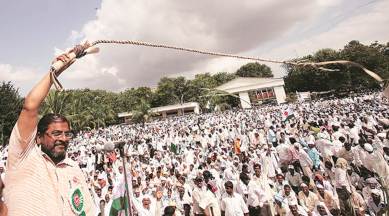Former foes, current friends: How Maharashtra’s Shetti & Cong-NCP found their way to each other
Over the last 20 years, Shetti and the farmers’ outfit headed by him, Swabhimani Shetkari Sanghatana, have carved a niche for themselves with the various agitations they have launched over cane payments.

Earlier this week, Swabhimani Paksha leader and sitting MP Raju Shetti filed his nomination from the Hatkanangle constituency in Kolhapur. In a massive show of strength, the farmer leader was accompanied by senior leaders of both the Congress and the NCP as Shetti is part of the grand opposition alliance. During the election campaign, Shetti will also share the stage with these leaders, who represent the very sections of society and pockets of power that he has been opposing for decades.
Shetti has become a mass leader by taking on the powerful sugar barons in western Maharashtra. Over the last 20 years, Shetti and the farmers’ outfit headed by him, Swabhimani Shetkari Sanghatana, have carved a niche for themselves with the various agitations they have launched over cane payments. The Sanghatana has ensured that cane growers are paid more than the government-declared Fair and Remunerative Price (FRP) in Kolhapur, Sangli and Satara. While the Paksha has expanded its network in other parts of the state, its electoral success has been restricted to Kolhapur and neighbouring regions. Click here for more election news
In the run-up to the 2014 Lok Sabha elections, Shetti was vocal in his opposition to the the Congress and NCP and targeted leaders such as NCP chief Sharad Pawar, senior leader Jayant Patil and others. During his very first foray in parliamentary polls, in 2009, Shetti defeated senior NCP leader Nivedita Mane from the Hatkanangle seat. In the 2014 elections, he teamed up with the BJP-led NDA and returned to the Lok Sabha after defeating former Congress minister Kallapa Awade.
So, when Shetti filed his nomination for the Lok Sabha polls this year with leaders like Patil, Congress MLC Satej Patil and others at his side, it signified a 180-degree turn in his politics.
The Congress and NCP have been eager to forge an alliance with Shetti for two reasons: his popularity as a farmers’ leader and the electoral might of his Paksha. Shetti had won over 53 per cent of the votes in Hatkanangle in the 2014 Lok Sabha elections, while the other prominent leader from his party at that time, Sadashiv Khot, had lost to NCP leader Vijaysinh Mohite Patil in Madha by a narrow margin of 25,000 votes.
Khot has since left the Paksha and joined the BJP.
The NCP and Congress are hoping to leverage the votes of the Paksha in the sugar belt of south and west Maharashtra, as well as benefit from the farmer leader’s image at a time of acute farm distress.
To take on Shetti, the Shiv Sena has fielded Dhairyasheel Mane, the son of his former rival, NCP leader Nivedita Mane.
For Swabhimani Paksha, being part of the alliance means getting the chance to fight from another Lok Sabha seat, with the might of political heavyweights Congress and NCP supporting the outfit.
While Shetti is the frontrunner in the electoral stakes in Hatkanangle, the victory of a Paksha candidate in another Lok Sabha seat will help the party get a fixed electoral symbol from the Election Commission.